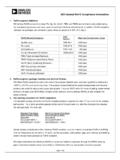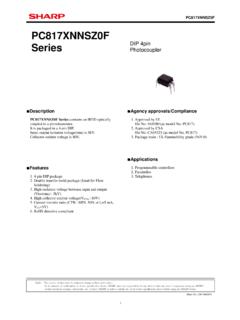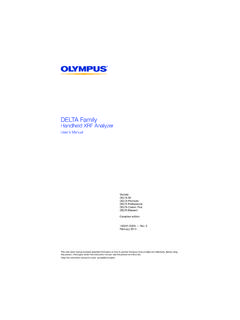Transcription of When does the China RoHS label apply? - ccilc.pt
1 Guideline: China rohs label China rohs label When does the China rohs label apply? China has enforced a measure Restricting the use of Hazardous Substances ( rohs ) in electronic equipment and the measure can in many ways be compared to the European rohs requirements. However key differences exist between the 2 measures and compliance with one does not mean compliance with the other. Formally known as the administration measure on the control of pollution caused by electronic information products the measure is commonly referred to as the China rohs and has been in effect since March 2007. The measure applies broadly to Electronic Information Products (EIP) which are maintained in a rohs catalogue by the Ministry of Industry and Information Technology (MIIT).
2 The catalogue currently contains more than 1800 products, summarised in the following categories: Summary of the main rohs catalogue 1. Radar equipment products includes airborne and ship borne radar 2. Communication equipment products transmitters, navigation, telephones, base stations 3. Broadcast television equipment products transmitters, camcorders, antennas 4. Computer products all types of computers, network equipment, printers, power supplies, CDs, toner cartridges, etc. 5. Household electronic products TV, DVD, video tapes, CDs, etc. 6. Electronic measurement instrument products test equipment, meters, etc. 7. Electronic products for professional use soldering tools, electric and air tools 8.
3 Electronic components passives, PCBs, sensors, connectors, switches, loudspeakers, electronic devices (vacuum tubes, diodes, semiconductors, ICs, electronic circuits, wire and cables, lamps and batteries). 9. Electronic application products, electronic material household equipment (games, microwave ovens), products, etc. medical devices *Source: - SJ/T 11363-2006 "Requirements for concentration limits for certain hazardous substances in electronic information products". 2011 EU SME Centre 1. Guideline: China rohs label The China rohs label is mandatory for products listed in the main catalogue and is based on self- declaration by the manufacturer. The 6 hazardous substances are identical to the European rohs but are still allowed.
4 Currently no Chinese rohs testing is required - pre-market control is conducted by the competent Chinese authorities. Besides the main catalogue listed above, the MIIT is preparing a key catalogue that will list products for priority enforcement (catalogue for priority prevention of pollution from electronic information products). Products listed in the key catalogue are subject to substance restriction requirements and testing will be integrated in the China Compulsory Certification scheme (CCC). On October 2009, the MIIT published a first draft of the key catalogue for public consultation, identifying 3 product categories, including mobile user terminals, telephones, and printers linked to computers.
5 However, to this date the key catalogue is yet to be enforced. There is no formal date set for enforcement of the key catalogue. What are the technical requirements? The China rohs is subject to 3 main mechanisms to control the use of hazardous substances in identified products, namely standards, the product catalogue and substitution materials. Maximum concentration levels are stipulated in SJ/T 11363-2006 "requirements for concentration limits for certain hazardous substances in electronic information products" covering the classification of materials for testing and their concentration levels. Toxic or hazardous substances and elements contained in products 1 Lead (Pb).
6 2 Cadmium (Cd). 3 Mercury (Hg). 4 Hexavalent chromium (Cr 6). 5 Polybrominated biphenyls (PBB). 6 Polybrominated diphenyl ethers (PBDE). * Other substances could be included in the future The concentration limits apply in different classes of material. There are 3 classes, each with specific applicable concentrations limits: 2011 EU SME Centre 2. Guideline: China rohs label Classification Definition of materials Limit requirements EIP-A Each homogeneous material The contents of lead, mercury, hexavalent chromium, composing EIP polybrominated biphenyl, polybrominated diphenyl ether (exclusive of decabromo diphenyl ether) in this category shall not exceed and the content of cadmium shall not exceed EIP-B Metallic coating of each part in The hazardous substances including lead, mercury, EIP cadmium, hexavalent chromium in this category shall not be added intentionally.
7 EIP-C Small components or materials The contents of lead, mercury, hexavalent chromium, that cannot be further polybrominated biphenyl, polybrominated diphenyl disassembled under existing ether (not including decabromo diphenyl ethers) in this conditions in EIP. They generally category shall not exceed , and the contents of refer to the products of equal to cadmium shall not exceed or less than 4 mm3 in size. Source: in SJ/T 11363-2006 "requirements for concentration limits for certain hazardous substances in electronic information products". Products can contain the hazardous substances, and should be marked according to the 2 rohs logos that identify if the product contains below or above concentration limits.
8 Marking requirements are stipulated in SJ/T11364-2006 "marking for control of pollution caused by electronic information products" covering the marking of the product, and GB/ T18455-2010 for the packaging. The SJ/T11364-2006 standard identifies 2 logos to be placed on the product: Green Logo Colour: green C85, M31, Y83, K20. Indicates that the EIP does not contain toxic and hazardous substances or elements above the maximum concentration values, and that it is an environmentally-friendly product which can be recycled and reused. Orange Logo Colour: orange C0, M75, Y99, K0. Indicates that the EIP contains toxic and hazardous substances or elements over the defined maximum concentration values defined above.
9 The names and content of the toxic and hazardous substances or elements shall be provided in the product instruction manual. The number in the symbol refers to the environment friendly use period. If the product is marked with the orange logo and contains hazardous substances above concentration limits, additional marking is needed. A table must be included in the product literature specifying substance levels following the below table: 2011 EU SME Centre 3. Guideline: China rohs label Name of Toxic or hazardous substances and elements part Lead Mercury Cadmium (Cr 6) (PBB) (PBDE). (Pb) (Hg) (Cd). Item 1 O X O O O O. Item 2 . * Source: SJ/T11364-2006 "marking for control of pollution caused by electronic information products".
10 The list must be provided in Chinese and boxes should be marked with either O or X. O indicates that the substance is below the concentration limits and X that it is above. The manufacturer can provide further technical explanations for marking X based on product conditions. Environment Friendly Use Period (EFUP). If the product contains any of the identified hazardous substances above the concentration limits, an Environment Friendly Use Period (EFUP) should be indicated. The EFUP is defined as the period during which the hazardous substances do not leak or mutate under normal use. Manufacturers are required to determine the EFUP by themselves, and to label the EFUP inside the orange symbol with a number of years.





